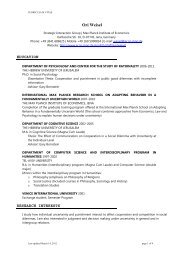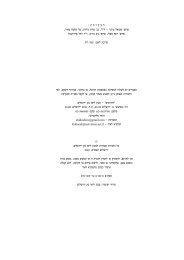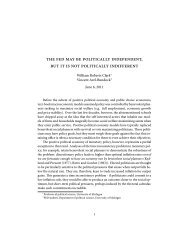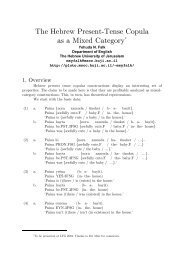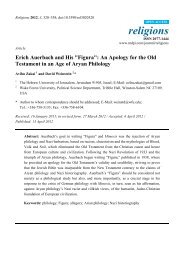Transitive verbs with non-accusative alternation in ... - Pluto Huji Ac Il
Transitive verbs with non-accusative alternation in ... - Pluto Huji Ac Il
Transitive verbs with non-accusative alternation in ... - Pluto Huji Ac Il
You also want an ePaper? Increase the reach of your titles
YUMPU automatically turns print PDFs into web optimized ePapers that Google loves.
70<br />
Rivka Halevy<br />
(18) ba-tmuna ro’im ‘oto maxziq {‘et/be-} yada<br />
<strong>in</strong>-the-picture see-3 MASC.PL him hold<strong>in</strong>g {OM/<strong>in</strong>-} her-hand<br />
‘In the picture you can see him hold<strong>in</strong>g her hand’<br />
(19) ha-’axbarim kirsemu {'et/be-} mexitsat ha-'ets be-mešex šana<br />
the-mice gnawed {OM/<strong>in</strong>-} the-screen of-wood dur<strong>in</strong>g year<br />
‘The mice gnawed {Ø/at} the wood screen over the course of a<br />
year’<br />
F<strong>in</strong>ally, it is relevant to note that the dative morpheme is <strong>in</strong> many languages<br />
a marker of def<strong>in</strong>ite and animate O’s, as for example the Spanish a and the<br />
Semitic dative le- which has become <strong>in</strong> Neo-Aramaic a marker of the<br />
def<strong>in</strong>ite <strong>accusative</strong>, e.g. qatlā le – kills 3 FEM.SG to-him ‘she kills him’. On<br />
this account Hopper and Thompson (1980: 259) suggest that the arguments<br />
known to grammar as ‘Indirect Objects’ (as opposed to ‘obliques’ such as<br />
<strong>in</strong>strumentals or locatives), whether dative marked or not, should <strong>in</strong> fact be<br />
transitive O’s rather than what might be called ‘<strong>accusative</strong>’ O’s, s<strong>in</strong>ce they<br />
tend to be def<strong>in</strong>ite or highly <strong>in</strong>dividuated. 11<br />
2.2.2. Involvement and affectedness of the O entity<br />
In the prepositional <strong>alternation</strong> of the transitive <strong>verbs</strong> at issue, the O is<br />
marked <strong>in</strong> terms of affectedness. The affected object represents an<br />
<strong>in</strong>dependent entity, whose existence is not stipulated by the action; however<br />
the action has an impact upon it. The be-preposition marks the realization<br />
of the contact between the A and the O. The action is focused <strong>in</strong>tentionally<br />
and <strong>in</strong>tensively on the O. In the <strong>accusative</strong> construction, on the other hand,<br />
the object is unmarked <strong>in</strong> terms of affectedness, and is susceptible of<br />
denot<strong>in</strong>g an effected object, viz., a nom<strong>in</strong>al entity constitut<strong>in</strong>g the last<br />
element of the verbal process, as shown above <strong>in</strong> (17) and <strong>in</strong> (20) below.<br />
(20) hi’ qar’a {Ø/??be-} pisa mi-nismato šel ‘avigdor (Kerrett, p.61)<br />
she tore {Ø/??<strong>in</strong>-} piece of-his-soul of Avigdor<br />
‘She tore off a piece of Avigdor's soul’<br />
The DO pisa (‘piece’) is <strong>in</strong>separable from the concept of the verb. It<br />
functions as an <strong>in</strong>cremental theme (<strong>in</strong> the sense of Dowty 1991), i.e. it does<br />
not exist <strong>in</strong>dependently of the event, and, as advocated by Delbecque<br />
(1999a, 1999b, 2002), it cognitively acts as an <strong>in</strong>ternally bounded doma<strong>in</strong>.



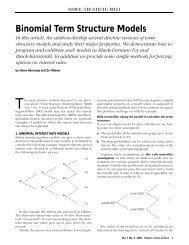
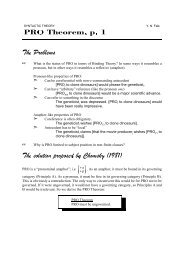
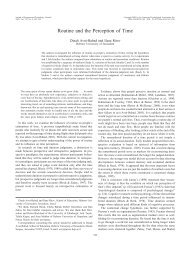
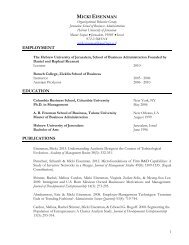
![CV [PDF] - Pluto Huji Ac Il](https://img.yumpu.com/18174585/1/190x245/cv-pdf-pluto-huji-ac-il.jpg?quality=85)

